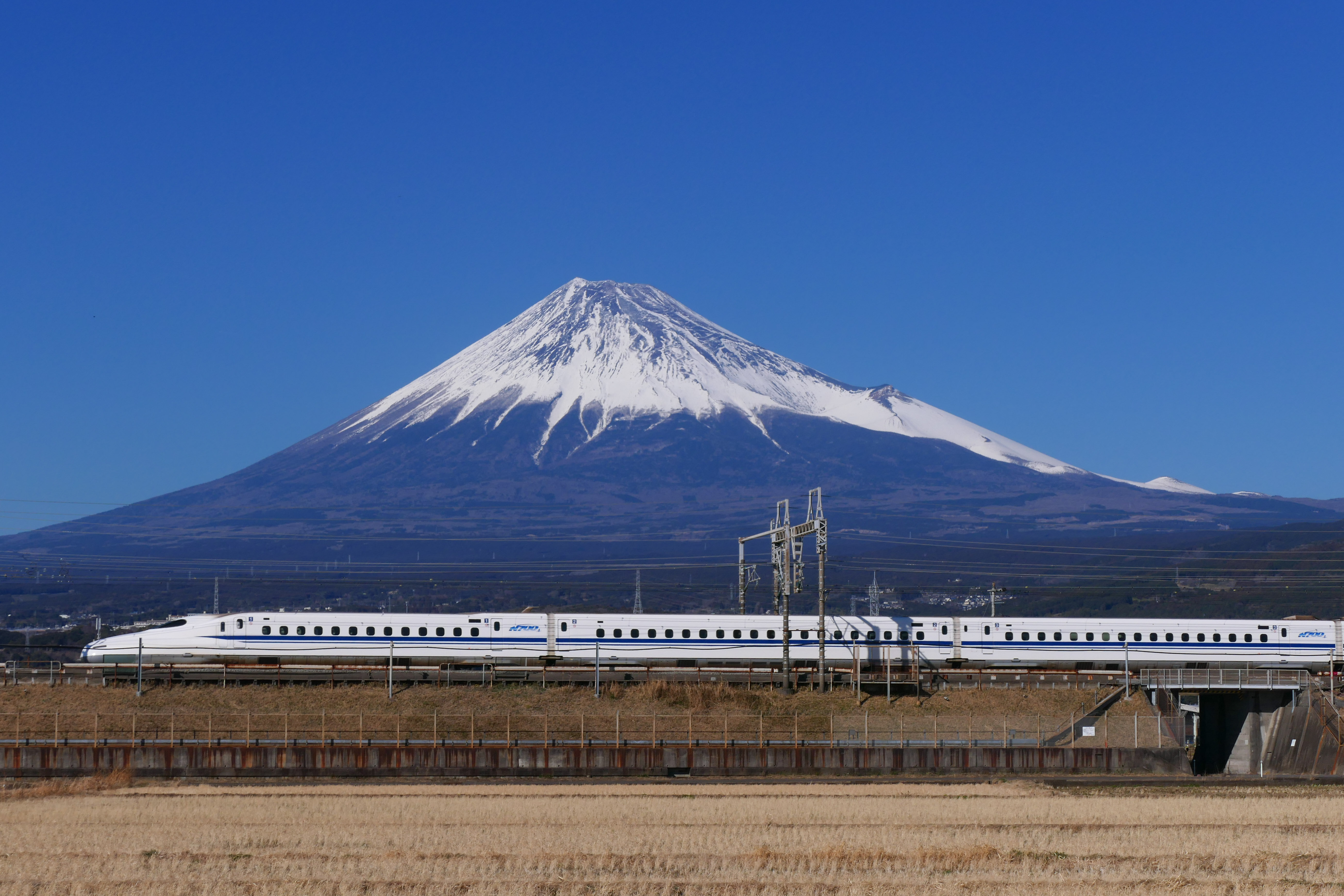
“Eiffel Tower” by photographer Tommie Hansen, 2013. Creative Commons 2.0. Included with appreciation.
Paris opens the Olympics today. One hundred years ago, in 1924, the city of lights last hosted the world’s games. What has changed? Each Olympic city endeavors to introduce innovations: this summer, many will reflect responses and solutions to climate change.

River Seine from Bercy by photographer Mortimer62, 2010: Creative Commons 2.0. Included with appreciation.
Beach volleyball will take place at the foot of the Eiffel Tower ( on a temporary beach of imported sand). Real sand will greet Olympic surfers who will ride the waves in Teahupo’o, Tahiti. For the opening ceremony, athletes will float down the Seine (the city’s mayor swam in the river to prove its cleanliness).

The 1964 Tokyo Olympics featured the new Shinkansen rail transit system -profitable from day one. Image: Shinkansen Series N700a at Mt. Fuji by photographer Maeda Akihito, 2021. Creative Commons 4.0. Included with appreciation.
Hosting the Olympics is both a financial danger and an opportunity for upgraded infrastructure. When Tokyo opened the 1964 Olympics, a new transit system debuted. Shinkansen, Japan’s famed train system, was completed just 10 days before. Timing was ideal: the new train line was profitable from day one, according to financial analysis by Japanese historian of technology Hoshimi Uchida. After the Olympics, Shinkansen expanded its reach: in 2022, there were 16,347 miles (27,245 kilometers) of tracks for trains carrying 382 billion passengers.

When Rio de Janeiro hosted the 2016 Olympics, supermodel Gisele Bündchen graced the opening ceremony. Image: Agéncia Brasil, 2016. Creative Commons 3.0. Included with appreciation.
But past performance is not a guarantee of future profits. When Tokyo opened the 2020 Olympics (held in 2021 due to the global pandemic) there were no tourists to ride the rails. Hosting was heroic but unprofitable, costing $20 billion. Athens hosted in 2004, building a stadium that not only racked up debt but, some economists state, may have ushered in a financial meltdown. Rio 2016 featured Gisele Bündchen strolling the opening ceremony to “The Girl from Ipanema.” But the city later had to sell off the newly-built Olympic Village at a financial loss. Looking at the numbers from past Olympics, Denver, Colorado bowed out of the running for the 1976 winter Games. Is hosting the Olympics worth it?
Barcelona improved urban infrastructure during its hosting of the Games. Image: “1992 Summer Olympics” logo. Included with appreciation.
Barcelona emerged, in 1992, as a model of success through Olympian planning. New beaches, new transport including rail and a new airport, new telecommunications systems were so effective that a new term in architecture and urban planning emerged: “the Barcelona Effect.” London’s 2012 Olympics proved a new environmental technology: the renovated West Ham tube station offered renewable electricity created by movement of people crossing floors that lighted the entire metro station. Laurence Kemball-Cook, then a graduate student at Loughborough University, designed the technology plan and later formed PaveGen to offer electric floors to offices, hospitals, schools, and other buildings (including dance clubs) with ample foot traffic.

Dominque Perrault, chief architect for the new Olympian facility at Seine-Saint-Denis, also designed the above pictured Hippodrome de Longchamp in Paris. Image: Madeira78, 2018. Creative Commons 4.0. Included with appreciation.
Will Paris 2024 be a success? Some see renovations in Seine-Saint-Denis – a cluster of 40 small towns – as a means to improve an area plagued by joblessness and crime. After the Games, the area may emerge reborn as a “mixity” of residential and business activity: 40 architects who worked with central planner Dominique Perrault will see if that vision endures. Some worry displaced residents could return only to be priced out. Sustainability is part of the plan: seats for an aquatic center are made from recycled plastic bottle caps collected by children in Seine-Saint-Denis schools. (Kimmelman 2024)
Among the many innovations Paris will bring to the 2024 Olympics is an underground cooling system that will keep athletes comfortable amid the rising heat levels related to climate change. The water-cooled (recycled) technology, part of the Paris vision to be carbon-neutral by 2050, is based on advanced geothermal technology.
Paris: city of COP21 the “Paris Agreement” and city of the 2024 Olympics. Image: “2015 Climate Conference poster,” public domain. Included with appreciation.
The Paris Olympics 2024 will take place in the same city that achieved the COP21 Paris Agreement; this summer’s Games may set new examples of how cities can respond to climate change for a more sustainable, renewable world.
Will Paris light the way for innovations that cities can adopt in climate change? Paris 2024 Summer Olympics Logo. Included with appreciation
Brooke, K. Lusk. Renewing the World: WATER, 2022. ISBN: 9798985035919. https://renewingtheworld.com
Davidson, Frank P. and K. Lusk Brooke, “Shinkansen – National High-Speed Railways,” Chapter 35, Building the World, Volume II, pages 669 -680, 2006. ISBN: 9780313333743.
Kimmelman, Michael. “Hosting the Olympics costs billions. What does a city get back?” 22 July 2024. The New York Times. https://www.nytimes.com/2024/07/22/magazne/olympics-city-redevelopment-paris.html
Pavegen.https://www.pavegen.com
Runnerstribe Admin. “Paris Olympics: A Cool Solution to Summer Heat.” 26 March 2024. https://runnerstribe.com/news/paris-olympics-a-cool-solution-to-summer-heat
Shadbolt, Peter. “Future cities may harvest energy from human footsteps” 2014. CNN. https://www.cnn.com/2014/12/30/tech/innovation/tomorrow-transformed-energy-harvesting/index.html

